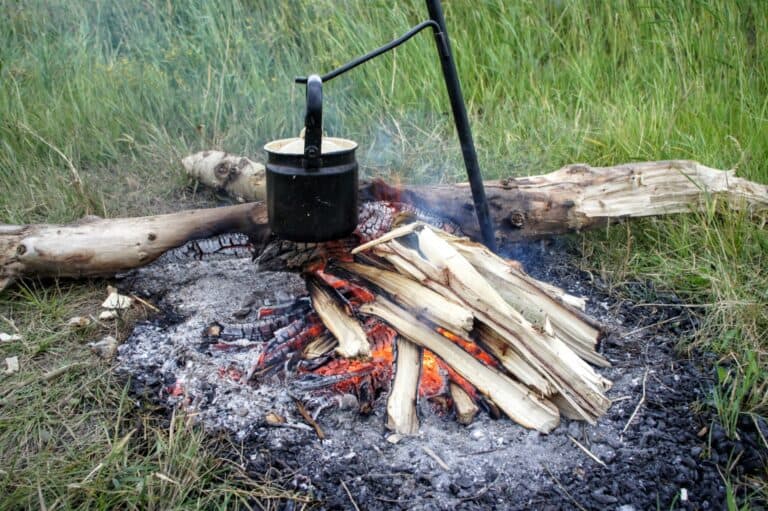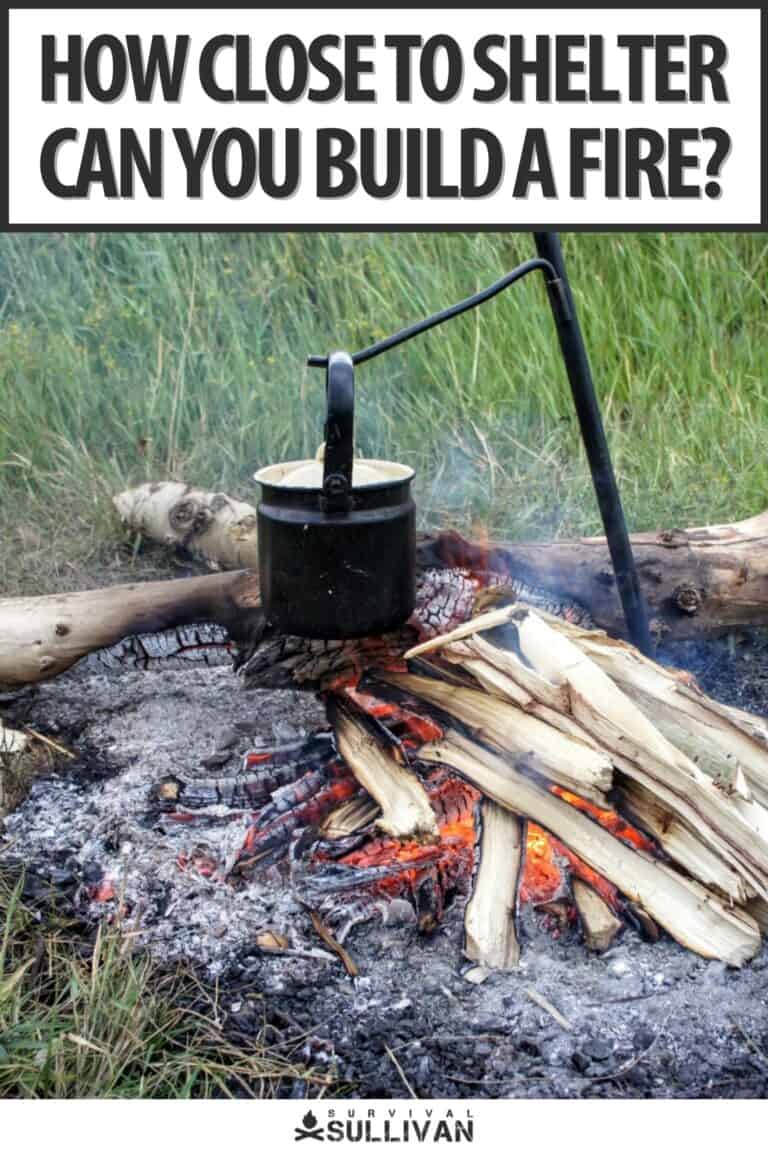When you are camping in the wilderness for any purpose, having a campfire is almost mandatory, particularly in colder climates or seasons.

The bite of cold weather will instinctively send most of us crowding closer to the fire, and there is hardly anything cozier than tucking into a tent or shelter with a roaring fire nearby. But just how close to your shelter can you safely build your campfire?
Your campfire should be no closer than 10 to 12 ft. from your shelter. Drifting sparks or embers from popping logs can easily ignite shelters made from natural materials, and even flame-resistant synthetic materials are vulnerable to burning or melting.
Even when the weather is at its coldest you’ll always need to be on guard against accidental fires.
Keep reading to learn everything you need to know about safely sitting your campfire and situating your shelter around it.
What is the “10 Foot Rule” for Campfires?
The 10 foot rule is a general guideline that tells you how close to your shelter you can safely build your campfire.
This rule takes into account the fact that sparks and flying embers from a fire can easily ignite a shelter made from natural or synthetic materials.
To be safe, your campfire should be at least 10 feet away from your shelter. This will give you enough space to build a fire without worrying about it being too close to your shelter to risk an accident.
Of course, the 10 foot rule is just a guideline and you’ll need to use your best judgment when sitting your campfire.
Make sure you consider the following information below to help you make an informed choice when building your campfire.
Primitive Shelters are Especially Vulnerable to Catching Fire
It should be obvious that improvised or primitive shelters made from natural materials like leaves, grass, and branches are highly flammable and should never be built too close to a campfire.
Even if you follow the 10 foot rule above, there is still a risk that sparks or embers from your fire could easily ignite these types of shelters.
If you are building a campfire near a shelter of this type, you’ll need to double your caution. Make sure you clear a wide space around your fire pit and keep a close eye on the fire at all times.
It’s also a good idea to have a bucket of water or sand nearby to extinguish any embers that land on the roof or walls of your shelter.
Tents, Tarps, Bivvies and Hammocks Can Melt or Burn, Too
While most tents and bivvies these days are made from fire-retardant materials, they are still vulnerable to burning or melting if they get too close to a campfire.
Sparks, embers or molten globs of sap or resin can easily burn a hole right through these materials.
Hammocks are another popular choice for camping, particularly in warmer weather. However, you should never hang your hammock too close to a campfire as with a tent. The direct heat from the fire can easily damage the thin fabric of your hammock.
All Materials Could Heat Up and Ignite Over Time
No matter if the material of your shelter is natural or man-made, all can heat up gradually over time and ignite if they are left too close to a campfire.
This can come as quite a rude surprise when the material was not directly exposed to open flames.
To stay safe, make sure you periodically check the temperature of shelter surfaces facing the fire to ensure they are not creeping toward combustion temperature. You can always move in closer later if needed and it is safe.
Clear All Flammable Material from Around the Fire
One of the most fundamental rules of campfire safety is still one of the most important, even in a survival situation.
You should always clear away any leaves, branches, grass or other flammable debris from around your fire pit and especially from between your shelter and the fire before building or lighting it.
Fire can easily ignite incidental materials, and then creep to neighboring materials, beginning a chain reaction that could quickly get out of control or burn down your shelter-maybe with you in it!
Even if you are following the 10 foot rule, consider it mandatory to clear the space around your fire. This will help to prevent any accidental fires from starting while you are asleep and unaware.
Pay Attention to the Wind
Wind is the factor that is most commonly associated with wildfires, but it can also play a role in how close to your shelter you can build a fire.
If the wind is blowing hard enough, sparks and embers from your fire could easily be carried aloft, even over surprising distances, and ignite materials that are away from the actual flames of the fire. Like your shelter, for instance…
For this reason, you should always pay attention to the wind speed and direction when sitting your campfire.
If the wind is blowing hard, it’s best to build your fire downwind from your shelter to minimize the risk of accidentally setting it on fire.
When in Doubt, Build Your Fire Further Away
If you’re ever unsure about how close to your shelter is safe to build a fire, err on the side of caution and build it further away.
It’s always better to be a little colder than to have to rebuild your shelter or worse, suffer serious injuries or perish in a fire.
With a little practice and experience, however, you will soon have the skill and confidence to build a safe fire no matter what the situation and no matter your shelter. And if you’re feeling up to it, know that, in some very specific situations, you can actually build your fire inside a shelter. But don’t try it unless you really know what you’re doing…
Tips for Getting the Most from Your Campfire
Remember, the key to building a safe campfire is understanding how fire behaves and using that knowledge to your advantage. Here are a few more tips to help you get the most from your campfire:
Build a reflector out of foil or other materials behind your tent. This will help to direct heat back towards you, instead of letting it escape into the night air.
Keep yourself well-insulated by wearing layers of clothing and using a blanket or sleeping bag. Your objective should be keeping warm and resting comfortably, not sleeping with just a T-shirt on.
Keep your fire stoked. Adding small amounts of wood regularly will help to maintain an even temperature and prevent the fire from dying down.
By following these tips, you can make sure that your next campfire is both effective and safe.


Tom Marlowe practically grew up with a gun in his hand, and has held all kinds of jobs in the gun industry: range safety, sales, instruction and consulting, Tom has the experience to help civilian shooters figure out what will work best for them.
